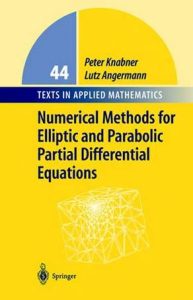Numerical Methods for Elliptic and Parabolic Partial Differential Equations
Peter Knabner, Lutz Angermann:
Numerical Methods for Elliptic and Parabolic Partial Differential Equations
Texts in Applied Mathematics, Vol. 44. Springer-Verlag, New York 2003, ISBN: 0-387-95449-X

The flyer can be found here.
Abstract:
This book covers numerical methods for partial differential equations: discretization methods such as finite difference, finite volume and finite element methods; solution methods for linear and nonlinear systems of equations and grid generation. The book takes account of both the theory and implementation, providing simultaneously both a rigorous and an inductive presentation of the technical details. It contains modern topics such as adaptive methods, multilevel methods and methods for convection-dominated problems. Detailed illustrations and extensive exercises are included. It will provide mathematics students with an introduction to the theory and methods, guiding them in their selection of methods and helping them to understand and pursue finite element programming. For engineering and physics students it will provide a general framework for formulation and analysis of methods providing a broader perspective to specific applications.
Table of contents:
0. For Example: Modelling Processes in Porous Media with Differential Equations
0.1 The Basic Partial Differential Equation Models
0.2 Reactions and Transport in Porous Media
0.3 Fluid Flow in Porous Media
0.4 Reactive Solute Transport in Porous Media
0.5 Boundary and Initial Value Problems
- For the Beginning: The Finite Difference Method for the Poisson Equation
1.1 The Dirichlet Problem for the Poisson Equation
1.2 The Finite Difference Method
1.3 Generalizations and Limitations of the Finite Difference Method
1.4 Maximum Principles and Stability - The Finite Element Method for the Poisson Equation
2.1 Variational Formulation for the Model Problem
2.2 The Finite Element Method with Linear Elements
2.3 Stability and Convergence of the Finite Element Method
2.4 The Implementation of the Finite Element Method: Part 1
2.4.1 Preprocessor
2.4.2 Assembling
2.4.3 Realization of Dirichlet Boundary Conditions: Part 1
2.5 Solving Sparse Systems of Linear Equations by Direct Methods - 3. The Finite Element Method for Linear Elliptic Boundary Value Problems of Second Order
3.1 Variational Equations and Sobolev Spaces
3.2 Elliptic Boundary Value Problems of Second Order
3.2.1 Variational Formulation of Special Cases
3.2.2 An Example of a Boundary Value Problem of Fourth Order
3.2.3 Regularity of Boundary Value Problems
3.3 Element Types and Affine Equivalent Triangulations
3.4 Convergence Rate Estimates
3.4.1 Energy Norm Estimates
3.4.2 The Maximum Angle Condition on Triangles
3.4.3 L2 Error Estimates
3.5 The Implementation of the Finite Element Method: Part 2
3.5.1 Incorporation of Dirichlet Boundary Conditions: Part 2
3.5.2 Numerical Quadrature
3.6 Convergence Rate Results in Case of Quadrature and Interpolation
3.7 The Condition Number of Finite Element Matrices
3.8 General Domains and Isoparametric Elements
3.9 The Maximum Principle for Finite Element Methods - Grid Generation and A Posteriori Error Estimation
4.1 Grid Generation
4.1.1 Classification of Grids
4.1.2 Generation of Simplicial Grids
4.1.3 Generation of Quadrilateral and Hexahedral Grids
4.1.4 Grid Optimization
4.1.5 Grid Refinement
4.2 A A Posteriori Error Estimates and Grid Adaptation - Iterative Methods for Systems of Linear Equations
5.1 Linear Stationary Iterative Methods
5.1.1 General Theory
5.1.2 Classical Methods
5.1.3 Relaxation
5.1.4 SOR and Block-Iteration Methods
5.1.5 Extrapolation Methods
5.2 Gradient and Conjugate Gradient Methods
5.3 Preconditioned Conjugate Gradient Method
5.4 Krylov Subspace Methods for Nonsymmetric Systems of Equations
5.5 The Multigrid Method
5.5.1 The Idea of the Multigrid Method
5.5.2 Multigrid Method for Finite Element Discretizations
5.5.3 Effort and Convergence Behaviour
5.6 Nested Iterations - The Finite Volume Method
6.1 The Basic Idea of the Finite Volume Method
6.2 The Finite Volume Method for Linear Elliptic Differential Equations of Second Order on Triangular Grids
6.2.1 Admissible Control Volumes
6.2.2 Finite Volume Discretization
6.2.3 Comparison with the Finite Element Method
6.2.4 Properties of the Discretization - Discretization Methods for Parabolic Initial Boundary Value Problems
7.1 Problem Setting and Solution Concept
7.2 Semidiscretization by the Vertical Method of Lines
7.3 Fully Discrete Schemes
7.4 Stability
7.5 The Maximum Principle for the One-Step-Theta Method
7.6 Order of Convergence Estimates - Iterative Methods for Nonlinear Equations
8.1 Fixed-Point Iterations
8.2 Newton’s Method and Its Variants
8.2.1 The Standard Form of Newton’s Method
8.2.2 Modifications of Newton’s Method
8.3 Semilinear Boundary Value Problems for Elliptic and Parabolic Equations - Discretization Methods for Convection-Dominated Problems
9.1 Standard Methods and Convection-Dominated Problems
9.2 The Streamline-Diffusion Method
9.3 Finite Volume Methods
9.4 The Lagrange–Galerkin Method
A. Appendices
A.1 Notation
A.2 Basic Concepts of Analysis
A.3 Basic Concepts of Linear Algebra
A.4 Some Definitions and Arguments of Linear Functional Analysis
A.5 Function Spaces
References
Index

